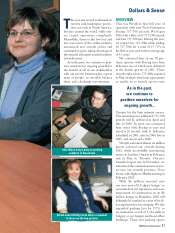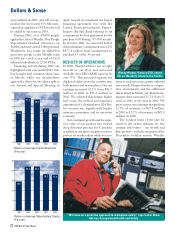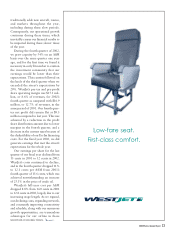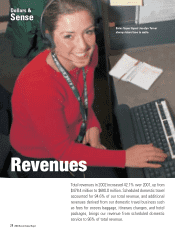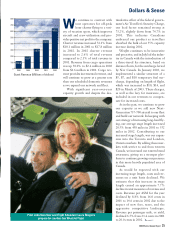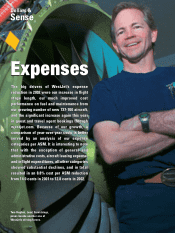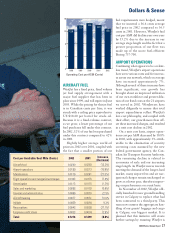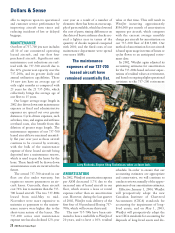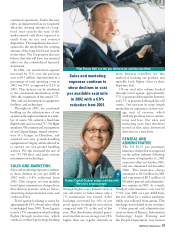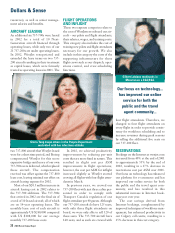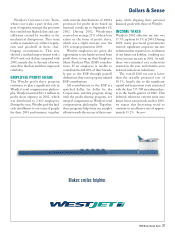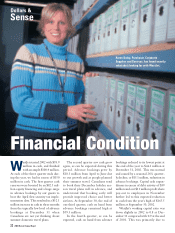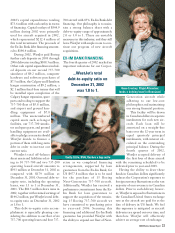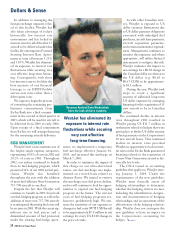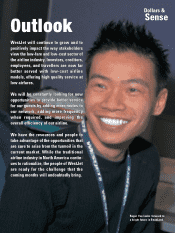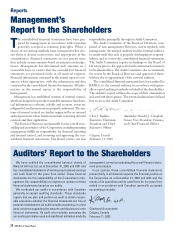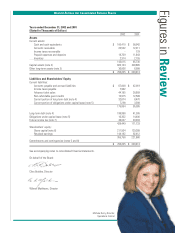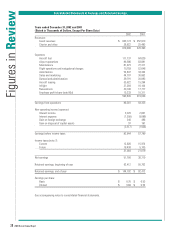Westjet 2002 Annual Report Download - page 28
Download and view the complete annual report
Please find page 28 of the 2002 Westjet annual report below. You can navigate through the pages in the report by either clicking on the pages listed below, or by using the keyword search tool below to find specific information within the annual report.
28 2002 WestJet Annual Report
Dollars & Sense
able to improve upon its operational
and customer service performance by
improving aircraft turn times and
reducing incidents of lost or delayed
baggage.
MAINTENANCE
Our fleet of 737-700 jets now includes
all 10 of our committed operating
leased aircraft, and our first four
purchased aircraft. Significant unit
maintenance cost reductions are real-
ized with the 737-700 aircraft due to
the 12% greater seat capacity over the
737-200s, and its greater daily and
annual utilization capabilities. These
14 new jets have an average age of
only eight months as compared with
25 years for the 21 737-200s, which
collectively brings the average age of
our fleet to 15 years.
Our longer average stage length in
2002 also drives down unit maintenance
expense as fixed and administrative
expenses are spread out over greater
distances. Cycle-driven expenses, such
as brakes, tires, and engine and airframe
overhaul costs, also benefit from this
dilution of greater stage length. The
maintenance expenses of our 737-700
leased aircraft have remained essential-
ly flat year over year as these aircraft
continue to be covered by warranty,
with the bulk of the maintenance
expense of these leased aircraft being
deposited into a maintenance reserve,
which is used to pay the lessor by the
hour. These funds will be drawn down
as maintenance costs are incurred in the
future.
The owned 737-700 aircraft in our
fleet are also under warranty, but
require no reserve payments to an air-
craft lessor. Currently, these aircraft
cost 76% less to maintain than the 737-
700 leased aircraft. The two 737-800s
leased from mid-May to mid-
November were more expensive to
maintain as payments to the mainte-
nance reserve were higher due to the
short-term nature of the leases. The
737-200 series unit maintenance
expense rate has also declined 12% year
over year as a result of a number of
elements: there has been an excess sup-
ply of parts available, which has lowered
the cost of parts; timing differences on
due dates of heavy airframe checks cre-
ated a lighter year in terms of the
quantity of checks required compared
with 2001; and the fixed costs of our
maintenance department were spread
over more ASMs.
value at that time. This will result in
WestJet incurring approximately
$196,000 per month of amortization
expense per aircraft, which compares
with the current average monthly
charge per aircraft for amortization on
our 737-200 fleet of $115,000. Our
method of amortization for our aircraft
is based upon usage in terms of hours or
cycles flown to an anticipated retire-
ment date.
In 2002, WestJet again adjusted its
accounting estimates for amortization
for the 737-200s based on lower expec-
tations of residual values at retirement,
and based on ongoing slight operational
revisions to the 737-200 retirement
schedule. In order to ensure that our
accounting estimates are appropriate
and conservative, we will continue to
conduct reviews annually of the appro-
priateness of our amortization estimates.
Effective January 1, 2004, WestJet
will prospectively adopt the new
Canadian Institute of Chartered
Accountants (CICA) standards for
accounting for impairment of long-
lived assets, and on May 1, 2003,
WestJet will prospectively adopt the
new CICA standards for accounting for
disposals of long-lived assets and dis-
The maintenance
expenses of our 737-700
leased aircraft have
remained essentially flat.
Larry Richards, Engine Shop Technician, takes a closer look.
AMORTIZATION
In 2002, WestJet’s amortization expense
per ASM decreased 1.7% due to the
increased mix of leased aircraft in our
fleet, which creates a lease or rental
expense rather than an amortization
cost. However, during the last quarter
of 2002, WestJet took delivery of the
first four of 30 purchased Boeing 737-
700s, which will reverse this trend.
The new 737-700s have been esti-
mated to have a useful life to WestJet of
20 years, and to have a 10% residual





